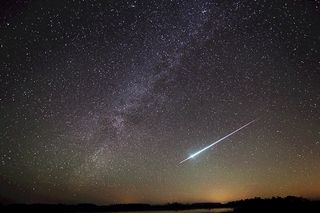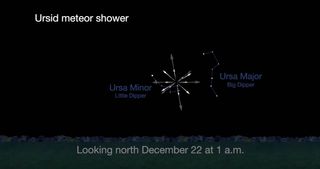The Ursid meteor shower peaks tonight. Don't expect to see many 'shooting stars.'
It's not a good year for December's "other" meteor shower.

According to the Observer's Handbook of the Royal Astronomical Society of Canada, there are 11 meteor showers that are considered to be the "principal" displays of the year. In order to make the list, a particular meteor shower must produce at least 10 meteors per hour at maximum.
As it turns out, within a span of only eight days during mid to late December, the meteor shower at the top of that list and the shower at the bottom of the list reach their peak.
Of course, there are the Geminids which is now considered the most prolific and reliable of all the annual meteor displays. And then, there is the "other" December shower that in stark contrast, hardly gets much notice at all: The Ursid meteor shower. This year, the peak of this meteor display is due during the pre-dawn hours of Wednesday, Dec. 22.
Related: See stunning pictures of the Geminid meteor shower of 2021
The Ursids are so named because they appear to fan out from the vicinity of the bright orange star Kochab, in the constellation of Ursa Minor, the Little Bear. Kochab is the brighter of the two outer stars in the bowl of the Little Dipper (the other being Pherkad), which seem to march in a circle like sentries around Polaris, the North Star.
A poor Ursid year
The fact that Kochab is positioned so near to the north pole of the sky means that it near never sets for most viewers in the Northern Hemisphere. And since the Ursids seem to fan out from this particular region of the sky, means that you can look for these faint, medium-speed meteors all through the night if you care to.
But this year the Ursids will be almost completely squelched under the light of the bright waning gibbous moon. With the peak of the Ursids coming just a few nights after the full moon, means that these meteors will be in direct competition with what will be in essence a giant celestial floodlight illuminating the sky on the first full night of winter.
Get the Space.com Newsletter
Breaking space news, the latest updates on rocket launches, skywatching events and more!
This is indeed a very unfortunate circumstance, since even when viewing conditions are far more favorable hardly anyone ever attempts observation of these meteors.

That observers have neglected the Ursids is not surprising. In contrast to the Geminids, which can produce up to 120 meteors per hour, the usual Ursid rate is but a fraction of that; generally speaking, they produce about 10 or so per hour at their peak. They are actually the dusty debris shed by the periodic Comet 8P/Tuttle, which circles the sun in a 13.6-year orbit and was last seen in early 2008 and due back in August 2021.
On occasion, the earth has interacted with a dense, narrow stream of particles shed by this comet, which has caused brief outbursts of Ursid meteors numbering in the dozens per hour, such as in 1945 and 1986; counts reached 30 per hour in 2000 and again during the years 2006 through 2008. Unexpected outbursts of activity may have occurred in other years, but if they did nobody apparently was around to see them. The most likely reason is their proximity on the calendar to the Christmas holidays, as well as the frigidity of late December nights.
So ... it appears that viewing conditions for the Ursids in 2021 will be "un-BEARable!"
As Dodger fans in Brooklyn used to say: better luck next year!
Joe Rao serves as an instructor and guest lecturer at New York's Hayden Planetarium. He writes about astronomy for Natural History magazine, the Farmers' Almanac and other publications. Follow us on Twitter @Spacedotcom and on Facebook.
Join our Space Forums to keep talking space on the latest missions, night sky and more! And if you have a news tip, correction or comment, let us know at: community@space.com.

Joe Rao is Space.com's skywatching columnist, as well as a veteran meteorologist and eclipse chaser who also serves as an instructor and guest lecturer at New York's Hayden Planetarium. He writes about astronomy for Natural History magazine, the Farmers' Almanac and other publications. Joe is an 8-time Emmy-nominated meteorologist who served the Putnam Valley region of New York for over 21 years. You can find him on Twitter and YouTube tracking lunar and solar eclipses, meteor showers and more. To find out Joe's latest project, visit him on Twitter.
Most Popular

